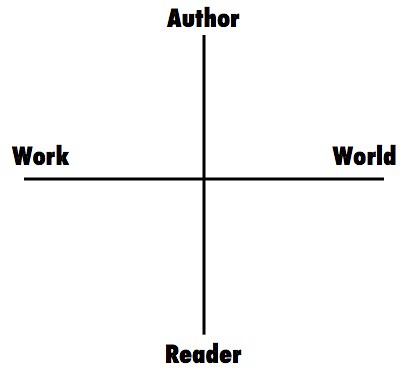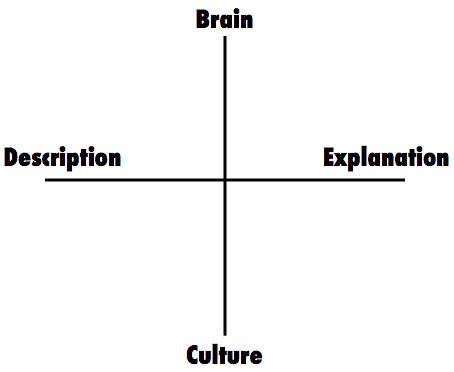I'm thinking of doing another version of this diagram, or something much like it. So I'm bumping this to the top of the queue. It's from September of 2015.While I’m in the business of thinking about the profession, here’s a short post about and old heuristic device, Richard Macksey’s graphic expression of an idea from Meyer Abrams, one of the founders of post-WWII literary criticism. That is, Abrams was of that generation of scholars who began the work of moving criticism to the center of a disciplinary matrix that had been devoted to philology and history. That’s the first section of this post. The second section gives my (radical) revision of that diagram.
The Abrams/Macksey Quadrant
In 1953 – the year Watson and Crick published their structural analysis of DNA – M. H. Abrams published The Mirror and the Lamp: Romantic Theory and the Critical Imagination. Though the book was about the development of English literary theory in the first half of the 19th century, not about the vicissitudes of the New Criticism, Abrams made some basic observations that influenced how critics began to interrogate their craft. Early in the book Abrams laid out what one might call the four-fold way: “Four elements in the total situation of a work of art are discriminated and made salient, by one or another synonym, in almost all theories which aim to be comprehensive” (p. 6). These elements are the work of art itself, the artist, the universe, and the audience. Abrams goes on to say: “Although any reasonably adequate theory takes some account of all four elements, almost all theories … exhibit a discernible orientation toward one only.”
When I studied with Richard Macksey in the late 1960s he had turned Abrams’ quartet into a pair of oppositions, artist and audience, work and world, and used them to mark the ends of orthogonal axes in a ‘space of criticism’ (not his term, nor am I proposing it as mine either; it’s merely convenient):
Macksey could then characterize a given critical approach according to where its interests fell in this space.
The New Critics obviously were oriented toward the work; their conception of form allowed them to separate the word from the other three. Reader response critics, equally obviously, are oriented toward the reader. Intentionalists – not the name of any critical school as far as I know, but a favored mode of argument back in the day – emphasized the author. Marxist critics would focus on the world, as does cultural studies.
A New Quadrant
Where am I?
If I take oral story-telling as a prototypical situation, then the distinction between author and reader collapses. The stories being told are traditional and the teller is only a custodian and conduit, not a creator. As everyone in the audience knows the tales they are not, in that respect, different from the author. Yet they do have different roles to play in the story-telling situation, no? How do we take that into account?
And, of course, we need to figure out whether or not the dynamics of this prototypical situation persist in a world of written texts. I think that they do. That is, in effect, what the much-misunderstood death of the author is about. But this obviously requires more discussion than is possible in this post.
My emphasis on description, would seem to be, and is, a focus on the work. But notice that when I talk of description, I also think of description as characterizing computational form. And the computation is being done but author and reader, story-teller and audience. And the world, that wouldn’t seem to figure into my approach at all.
Keep in mind however, that description is only a starting point. There is also explanation. And explanation looks to the mind/brain, but it also looks to the world, though I certainly haven’t emphasized that in my thinking and writing. But it shows up, for example, in the work I did on Matthew Jockers’s Macroanalysis when I treated the time course of different topics as indicating large-scale events and phenomena in the external world (e.g. the American Civil War) [1].
Provisionally, I offer you this re-vamped critical space:
Description is of the formal features of the text, but those formal features are considered to be traces of a computational process. That process is carried out by the brain, brains of authors and readers, story-tellers (including makers of movies and television) and audience. Cultural mechanisms ‘project’ the minds (embodied in brains) from individuals to the group or, if you will, from the group (e.g. those assembled to listen to a story, watch a movie) to the individual. Culture is also the ‘interface’ or ‘conduit’ to the external world, to history and society. Socio-cultural mechanisms determine what is culturally salient and thus what will be the focus of expressive culture. Explanation is about figuring out how all these others work together.
That’s a first cut, off the top of my head – though that second diagram has been kicking around on my hard drive for two or three years. I originally created it as a heuristic device to characterizing my own work. Obviously, for example, my work on ring-composition [2] is descriptive in nature. My early work on cognitive science was heading toward the brain and, in fact, at one point Hays and I did write an article on the brain [3] and the brain has figured in my work on music [4] and on relatively recent work about the adaptive value of literature [5]. My work on cultural evolution is, obviously, about culture [6]. Though much of that work is not about specifically literary culture, some of it is [7]. As for explanation, I’ve got explanatory gestures all over the place. But I hope that burden will be taken up by others.
Homework Assignment
I leave it as an exercise for the reader to locate the concerns of the old quadrant in this new one. My basic impulse would be to explore how each pole of the old quadrant is expressed in each pole of the new.
References
[1] Reading Macroanalysis: Notes on the Evolution of Nineteenth Century Anglo-American Literary Culture, Download: https://www.academia.edu/8183111/Reading_Macroanalysis_Notes_on_the_Evolution_of_Nineteenth_Century_Anglo-American_Literary_Culture
[2] Ring Composition: Some Notes on a Particular Literary Morphology, Download: https://www.academia.edu/8529105/Ring_Composition_Some_Notes_on_a_Particular_Literary_Morphology
[3] William Benzon and David Hays, Principles and Development of Natural Intelligence, Journal of Social and Biological Systems 11, 293 - 322, 1988. Download: https://www.academia.edu/235116/Principles_and_Development_of_Natural_Intelligence
[4] Beethoven’s Anvil: Music in Mind and Culture. Abrams 2001. Download final draft of 2nd and 3rd chapter: https://www.academia.edu/232642/Beethovens_Anvil_Music_in_Mind_and_Culture
[5] Literature, Emotion, and Unity of Being, Download: https://www.academia.edu/8296741/Literature_Emotion_and_Unity_of_Being
[6] You can download any of 15 published articles and working papers here: https://independent.academia.edu/BillBenzon/Cultural-Evolution
I recommend two of the older ones:
Culture as an Evolutionary Arena. Journal of Social and Evolutionary Systems 19(4) 1996: 321-361. This is my first attempt to theorize a Darwinian process in the cultural domain. I’ve completely rethought memes and cultural phenotypes in more recent work, but there’s still a lot here that I like. Download: https://www.academia.edu/235113/Culture_as_an_Evolutionary_Arena
Music Making History: Africa Meets Europe in the United States of the Blues. Nikongo Ba'Nikongo, ed., Leading Issues in Afro-American Studies. Durham, North Carolina: Carolina Academic Press, 1997: 189-233. While I don’t mention cultural evolution in the essay, it was in the back of my mind that I was tracing an evolutionary process. The point is that this particular evolutionary development has been a meaningful force in history. Download; https://www.academia.edu/8668332/Music_Making_History_Africa_Meets_Europe_in_the_United_States_of_the_Blues
[7] On the Direction of Cultural Evolution: Lessons from the 19th Century Anglophone Novel. Download: https://www.academia.edu/12112568/On_the_Direction_of_Cultural_Evolution_Lessons_from_the_19th_Century_Anglophone_Novel
On the Direction of 19th Century Poetic Style, Underwood and Sellers 2015. Download: https://www.academia.edu/13279876/On_the_Direction_of_19th_Century_Poetic_Style_Underwood_and_Sellers_2015


No comments:
Post a Comment